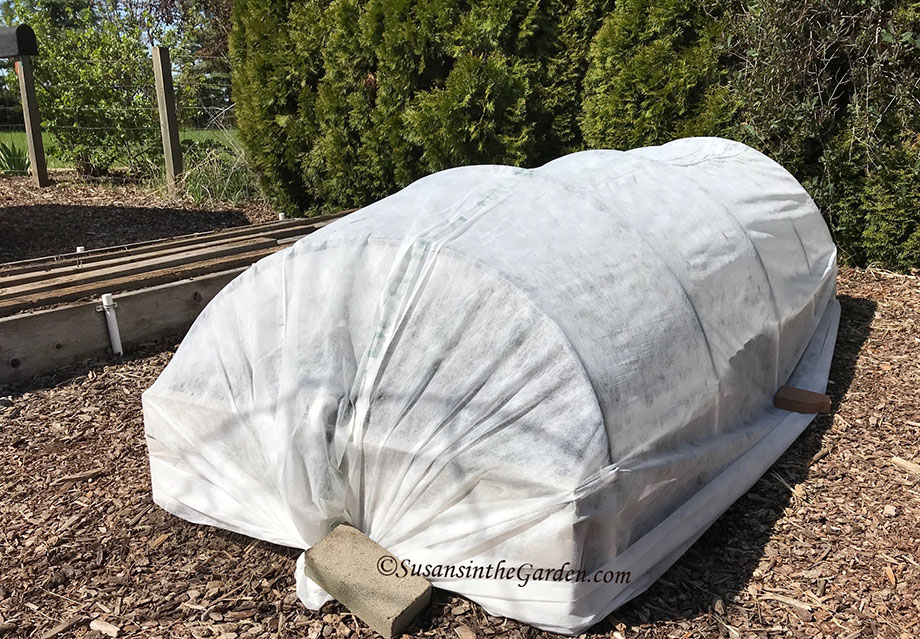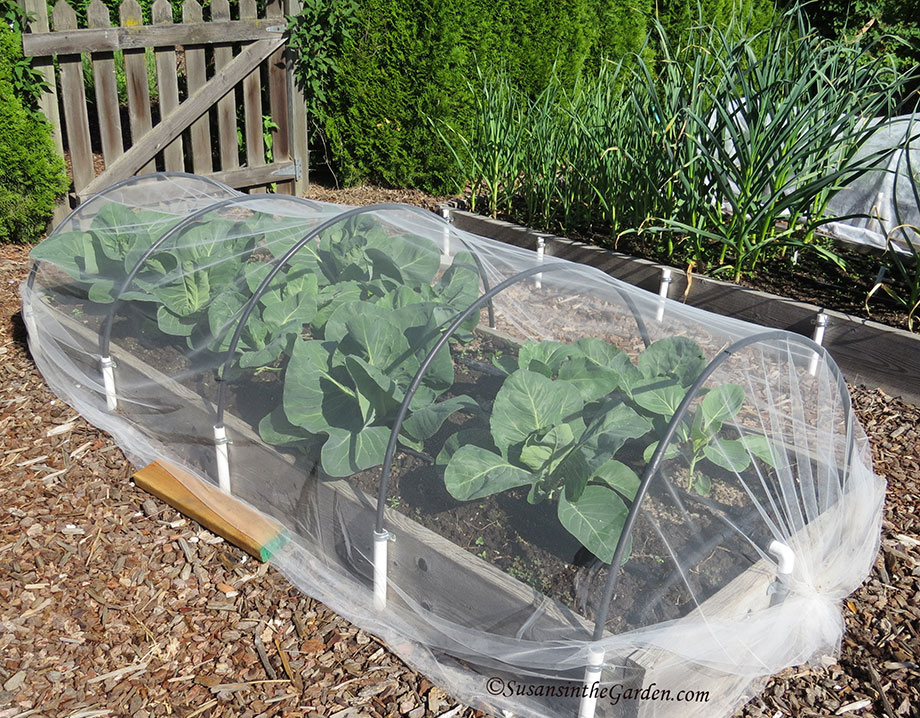Aug. 1 Column: Row Covers in the garden

As you probably already know, I’m a huge fan of using row covers in my garden. This includes floating row cover, bridal veil netting, shade cloth and bird netting. That is the topic of this week’s garden column, which you can read in today’s edition of The Spokesman-Review: Covers help keep vegetable crops happy and healthy. (or you can read the text of my column underneath the video below)
A couple of months ago, I received an email from a reader about this. She was curious what I use and under which circumstances so she could put row covers to use in her own garden. As I replied, I started realizing that this would make a great topic for a column! (I love it when that happens, LOL)
And guess what? This is also the topic of my newest video. In both my column and video, you’ll learn what floating row covers are, the different weights they come in, how they work for season extension, and which crops I cover with floating row covers and why. I also discuss other purposes for floating row cover, why I occasionally use bridal veil netting (a.k.a. “tulle”), which weights of shade cloth to use when temperatures really heat up (boy, did we need them this summer), and which crops I grow under bird netting. And there’s even more information than that!
As I mentioned in my video, I’ve occasionally pointed out that I’m using a row cover over one or two of our raised beds but I felt it was high time I shot a video that was ONLY about row covers. I hope you’ll agree and that you find this information really useful.
And here is my garden column:
By Susan Mulvihill
For The Spokesman-Review
During the garden season, I often use different types of covers over some of my vegetable plants. Since I’m frequently asked about this, I thought it would be helpful to explain when and why I use row covers, bird netting and shade cloth in order to keep my plants happy, healthy and free of pests.
Row cover is the most useful tool in my organic gardening toolbox. I use two types: floating row cover and bridal veil netting.
Floating row cover is a lightweight, woven fabric that allows sunlight and moisture to pass through it. There are two vegetable plant families that really benefit from this. The first is the cabbage family which includes broccoli, cabbage, cauliflower, kale, kohlrabi, radishes, rutabagas and turnips. All of these plants are bug magnets because aphids and cabbage worms can cause a significant amount of damage, primarily to their leaves.
I also use floating row cover over beet family crops, which include beets, spinach and Swiss chard. Their nemesis is the leafminer fly. The females lay eggs on the leaves, which hatch into small maggots that tunnel between the layers of cells within the leaves. I don’t know about you but I would rather not eat wormy greens.
Members of these two plant families do not require any pollination which means I can cover the crops with a layer of floating row cover as soon as I plant the seeds or seedlings. The row cover works as a physical barrier to keep these damaging pests away from the plants. I suspend it on hoops over the planting and am careful to weigh it down with bricks or blocks of wood since row cover is only effective when insects can’t gain access to the plants.
Floating row cover also gives plants a few degrees of frost protection, both early and late in the growing season. I even use it to cover warm-season crops such as tomatoes, peppers, melons, squash, pumpkins and eggplants at planting time. This gets the young seedlings off to a warm start for two to three weeks, then I remove the covers to allow for pollination.
Bridal veiling netting, also known as tulle, is another type of row cover that I use over cabbage family crops. I’ve found these plants prefer good air circulation, which tulle provides, while still acting as a physical barrier against insects. It’s also easier to see how the plants are doing without having to lift the cover. I purchase premium-quality tulle because it has tiny holes that most aphids can’t get through. This netting is more fragile than floating row cover so it’s important to handle it gently.
We have a lot of birds in our garden that enjoy nibbling on our lettuce patch so I always cover that bed with bird netting. It’s very effective. I can get away with using the larger-holed bird netting because I don’t have to keep small insects away from the plants.
Prior to this year, I haven’t needed to use shade cloth in my garden but it sure came in handy when our temperatures rose well over 100 degrees F. I suspended it over our tomato plants, as well as our broccoli and pepper beds.
Shade cloth comes in different shading percentages. I used 30 percent over our sun-loving tomatoes and peppers, and 60 percent over the broccoli since it’s more tolerant of shade. I don’t use row covers for this purpose because they trap and even amplify the heat. If I only had row covers at my disposal, I would suspend them above the plants but leave the sides open to allow for good air circulation.
All of these covers are so helpful for protecting certain crops from insect damage and birds, or for giving them a bit of relief from the intensity of the sun.
Susan Mulvihill is author of “The Vegetable Garden Pest Handbook.” She can be reached at Susan@susansinthegarden.com. Watch this week’s “Everyone Can Grow a Garden” video at youtube.com/susansinthegarden.


